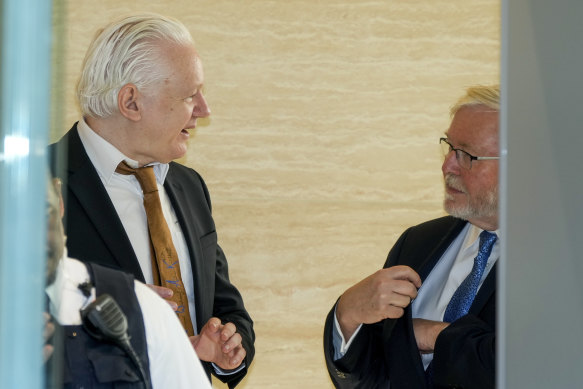- Analysis
- World
- Asia
- Assange saga
This was published 9 months ago
The dark footnote in the history of tiny island where Assange was freed
Saipan, Northern Mariana Islands: At the northernmost tip of the island of Saipan, in the remote turquoise expanse of the Pacific Ocean, there is a memorial to hundreds of Japanese civilians and soldiers who jumped to their deaths to avoid being captured by invading American forces in World War II.
Eighty years later, inside a small court overlooking the same tropical waters, WikiLeaks founder Julian Assange took his first steps as a free man in more than a decade, ending his own 14-year-long saga to evade capture by the United States.
It took US District Court Judge Ramona Manglona just under three hours to grant the WikiLeaks founder his liberty, as she walked the court through the plea deal that would see him released immediately. His five-year sentence was considered time served after half a decade spent in London’s Belmarsh Prison.
The echoes of history were not lost on the Sapian-born and raised judge, who reminded the court of the bloody battle that claimed the lives of 3000 American soldiers and many, many more Japanese casualties.
“I would just note to you that this past week, the island has been celebrating 80 years of peace since the Battle of Saipan. This was a very bloody place for Japanese and Americans,” Manglona said, addressing Assange directly.
“We’ve been celebrating a peace here with a former enemy. And now there’s some peace that you need to restore yourself when you walk out and pursue your life as a free man.”
There was a tremble in the Australian’s voice as he thanked Manglona. The gravity of the ordeal washed over his face and he nodded his head ever so slightly as the court adjourned for the final time in the case of the United States versus Assange.
Fewer than 100 people squeezed into the courtroom to watch the proceedings on Wednesday, among them the Australian diplomatic firepower – ambassador to the US Kevin Rudd and UK high commissioner Stephen Smith – who played a role in getting the deal across the line.
With the proceedings over, Assange grasped the hands of his long-serving lawyer, Jennifer Robinson, the Australian barrister who had been by his side for more than a decade.
Turning to the prosecution bench, he shook hands and exchanged some light banter with US counsel Matthew McKenzie.
The decision to hold Assange’s sentencing hearing on Saipan, the capital of the barely known US-controlled Northern Mariana Islands, was critical to the deal his lawyers struck with US officials. In exchange, he pleaded guilty to one espionage charge while more than a dozen were dropped.
To his supporters, Assange became a political martyr who revealed the most egregious of government secrets – evidence of war crimes and torture – and paid the price with ailing mental and physical health as he fought extradition to the US to face espionage charges.
The island of Saipan became a compromise solution, closer to his Australian home than the US mainland, where, his lawyers argued in years-long appeals, he would not face a fair trial.
For Assange’s unrelenting critics – those who loathed him for revealing state secrets and regard him not as a journalist but a traitor – his freedom will be a bitter pill.

Julian Assange speaks with Australian ambassador to the US Kevin Rudd on Wednesday.Credit: AP
After 14 long years, choosing from simple labels like hero or villain is perhaps too difficult for many Australians.
The case of the peculiar, silver-haired computer savant has taken so many twists and turns over the years that it has been difficult to keep up.
There was a rape investigation opened and then dropped; a long and at times bizarre stint in an Ecuadorian embassy followed by five years in a London prison; allegations of collaborating with Russian intelligence to publish hacked US Democratic Party emails; and so many legal appeals that, by the end, even some of his staunchest detractors concluded that enough was enough.
With this chapter closed there will be inevitable questions about what comes next. One can’t imagine Assange going quietly into the night.
Get a note directly from our foreign correspondents on what’s making headlines around the world. Sign up for the weekly What in the World newsletter here.